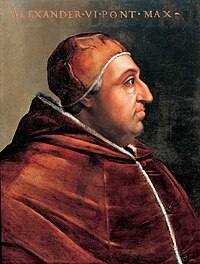Borgo (rione of Rome)
Emperor Hadrian built near the Tiber his huge Mausoleum, which he connected to the left bank of the river with another Bridge, the Pons Ælius (today's Ponte Sant'Angelo).
During the early Middle Ages the bridge of Nero fell into ruins, while the Mausoleum of Hadrian was converted into a stronghold (Castel Sant'Angelo), the possession of which ensured control of the city.
During the 8th and 9th centuries, the quarter – together with the basilica - was plundered several times by Saracens who landed in Portus,[11] and devastated by fires (that of 847 was immortalised by Raphael in a fresco painted in the stanze vaticane).
Since that time, the quarter was no longer considered a part of Rome, but a separate town, the Leonine City (Civitas Leonina), with its own magistrates and governor.
In his Divine Comedy, Dante describes the great crowds of pilgrims visiting the Leonine City during the first Jubilee, which took place in 1300 under Boniface VIII.
[15] come i Roman per l’essercito molto, l’anno del giubileo, su per lo ponte hanno a passar la gente modo colto,
The Portica collapsed, and on its place was built the road of Borgo Vecchio,[16] also named Carriera Martyrum after the martyrs going to death in the Circus of Nero.
[17] The large amount of building activity and above all the rebuilding of Saint Peter, which was the ultimate result of this translocation, attracted several artists to the Borgo, while the renewed flood of pilgrims boosted commerce.
Also wealthy bourgeoises, such as Febo Brigotti and Jacopo da Brescia, the doctors respectively of Paul III and Leo X, had their houses built in the Borgo.
These buildings, whose tradition came from Germany (the name comes from the German word stube), were something between a Roman bath and a modern sauna, and were often attended by artists, who could freely sketch nudes there (Raffaello himself was owner of a stufa in Borgo, near his palace).
The golden Age of the Borgo reached its apogee during the reign of the two Florentine Popes, Leo X and Clement VII, both members of the Medici family.
Paul III restored the walls, erecting three new ramparts and the still unfinished Porta Santo Spirito (the work of Antonio da Sangallo the younger).
On December 9, 1586 (the year when Domenico Fontana erected in Saint Peter's Square the obelisk once standing in the Circus of Nero), Pope Sixtus V declared Borgo the fourteenth Rione of the city.
[27] At the beginning of the 17th century Pope Paul V restored the Aqua Traiana, an ancient Roman Aqueduct, and had several fountains built in the Rione (among them, that designed by Carlo Maderno in Piazza Scossacavalli,[28] now placed in front of the church of Sant'Andrea della Valle).
The bourgeoises abandoned the rione for the new settlements in Campo Marzio, and Borgo became a quarter inhabited by simple people (artisans or workers at the Vatican), very devoted yet always open to new ideas, and men of the church, who appreciated the vicinity to the Holy See.
At the edge of the quarter, in Vicolo degli ombrellari, a small lane near Borgo Pio, were the shops of the Roman umbrella makers, gathered there because of the bad smell coming from the oiled silk.
In fact, the executioner was forbidden to live on the left bank, and even to go there (Boia non passa Ponte, in English: "the headsman cannot cross the bridge", was a Roman proverb), but had to stay in the Leonine City.
[33] The most important yearly event for the rione was the spectacular procession of Corpus Domini, which started and finished in Saint Peter's, and was led by the Pope himself together with the Cardinal Dean, during which each building was dressed with flags and standards.
The Préfet of Rome, Camille de Tournon, started the demolition of the spina, but the project had to be interrupted shortly after it began due to a lack of funds.
When, shortly after the September 20, 1870 the Italians offered the Pope full sovereignty over the Leonine City with all its inhabitants, this caused violent demonstrations in the Borgo.
Two Propylaea were built in front of Saint Peter's Square (inside that on the south side was enclosed the ancient church[36] of San Lorenzo in piscibus), and two others at the beginning of the road.
In fact, besides the destruction of many ancient edifices and, above all, of a whole social tissue, what was lost forever was the "surprise" (typical of the Baroque), when, at the very end of the narrow and dark lanes of the Borgo, the huge Piazza and Basilica suddenly appeared.
Since 1950, the remaining Borghiciani (the name by which the inhabitants of the Borgo are called in Roman dialect), live north of the Passetto, where the quarter retained until recent times its character.
[43] South of the Passetto the quarter houses only some offices (mainly belonging to the Vatican), an Auditorium, and the huge complex of the Hospital of Santo Spirito.
The territory of the rione includes a level part, which is made up of the Tiber's alluvial deposits, and a hilly zone, which coincides with the clay-laden slopes of the Vatican hill.
Southward, Borgo borders with Trastevere (R. XIII), the boundary being outlined by the Aurelian Walls, up to Ponte Principe Amedeo Savoia Aosta.
Although heavily transformed during the first half of the 20th century, Borgo maintains its historical importance as a forecourt to Saint Peter's Basilica and the Vatican Palace.









